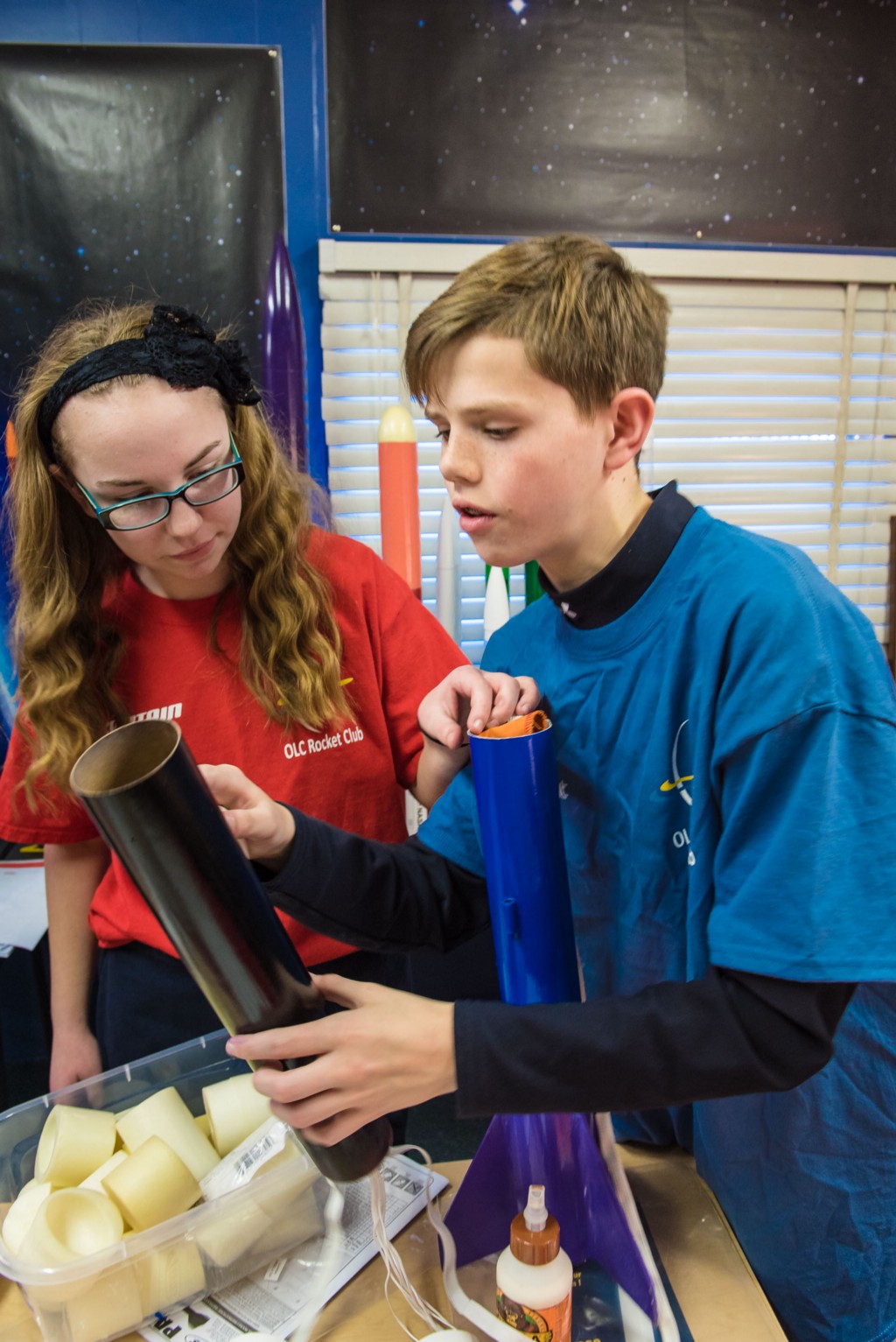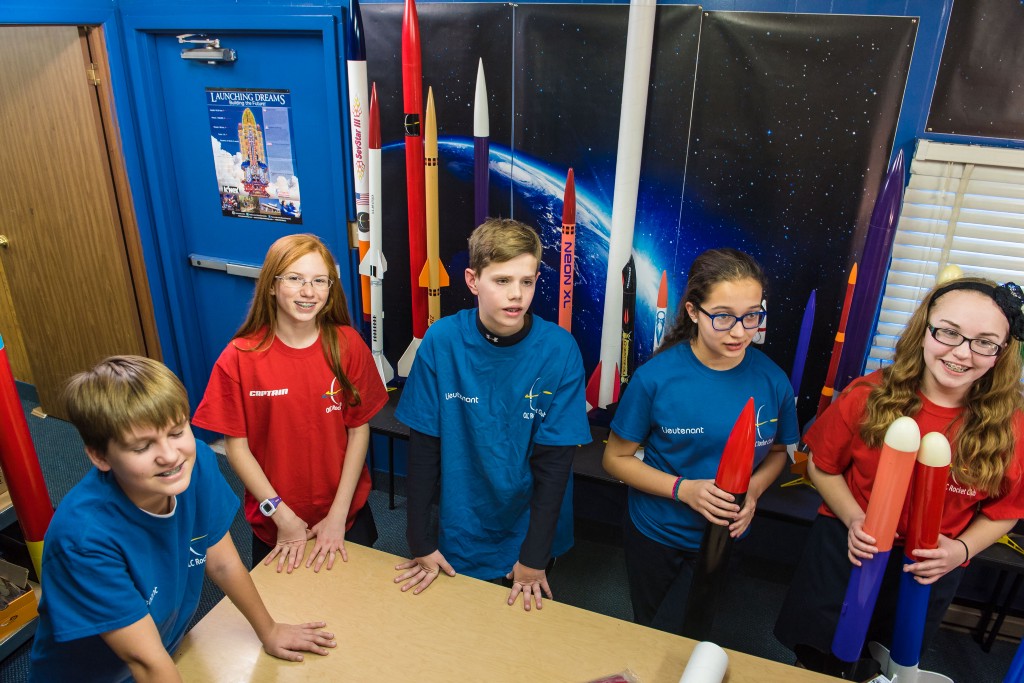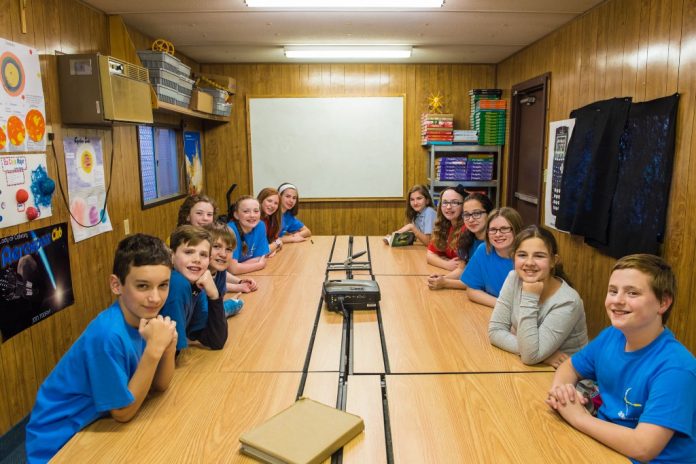The dream team: Students gather in the Rocket Lab at Our Lady of Calvary School during a meeting to discuss rocket designs and mechanical details. MARIA S. YOUNG / TIMES PHOTO
At first glance, it might easily be confused for a trailer full of arts and crafts supplies, but there’s a lot more to the Rocket Lab at Our Lady of Calvary School than that.
In this headquarters of math, science and imagination, paper tubes, glue, elastic bands, balsa wood and eggs become capsules, engine retainer systems, swept delta fins, launch lugs, parachutes and “egg-stronauts.” And for each of about a dozen sixth-, seventh- and eighth-graders who staff the lab, two afternoons a week might someday lead to a college scholarship and a coveted, lucrative career in the aerospace industry.
Calvary’s extracurricular Rocket Club is less than two years old, but its members are already competing on the same playing field as students two, three and four years older than they are. Last weekend, they furthered their effort to qualify for the Team America Rocketry Challenge, a May event in Virginia where their designs will be matched against about 800 other mostly high school groups from across the nation. Top performers will be eligible for a share of $100,000 in scholarship awards.
“We started building small rockets with basic skill levels, then progressed into moderate designs. By (last) September, we were ready to start building the big ones,” said Greg Severino, the honors math and STEM teacher who directs the rocket program. “So their level of competency is flourishing.”
Severino has been a teacher for 23 years, including the last 16 at Calvary, a school serving about 800 students K through 8. He’s always had a passion for rocketry and physics, too. Severino long sought to share that personal interest with his students and created the Rocket Club in September 2014. Severino spent months authoring a 74-page illustrated program guide outlining the history of rockets, the materials needed for the program and design principles, among other topics.
“It’s extracurricular yet it’s integrated into the honors math curriculum,” Severino said. “[In the club] we use practical applications that are relevant to the curriculum.”
In other words, students learn how to apply math and physics principles in the field.
About 10 pupils formed the inaugural club. At first, they met in a standard classroom. Then last summer, an auxiliary classroom next to the main building became available as a permanent dedicated home for the program. Now all systems are go.
“I wanted to be involved in something at school and rockets seemed a good place to start because I want to be an engineer,” said seventh-grader Ilinca Vilceau.
“I thought it would be cool to learn something different because everything is about sports. And I thought it would be something cool to do with my friends,” agreed Fiona Buck, another seventh-grader.
In the Team America program, a project of the National Association of Rocketry, teams are capped at 10 members each. So the Calvary students formed two squads. Eighth-grader Ciara Dubeck captains the Sky Raiders, while seventh-grader Korianna Rosenthal captains the Soaring Six. Each group develops its own rockets, but they support each other by sharing information and ideas.
“We give out jobs for the team members and are in charge of engineer notebooks,” Dubeck said, explaining the duties of the captain.
The task for each is to build a rocket from basic materials that will achieve specific performance outcomes. For the Team America challenge, also known by the acronym TARC, teams must build one rocket that reaches an altitude of precisely 850 feet with an elapsed flight time of 45 to 47 seconds. The teams must also build a second rocket that will reach 825 feet with a flight time of 24 to 26 seconds from launch to touchdown.
Students consider many variables and physics calculations in the design process. The disposable engines they use burn a proprietary powder to generate thrust. Engine sizes vary. Other factors include friction, center of gravity and center of pressure. In the lab, they use computer software to simulate test flights. Then the construction process begins, followed by live testing.
They cannot test at school, however, because the area is too congested. In November, the teams traveled to a soybean farm in Cross Keys, New Jersey, for testing. They were encouraged by the results. Last Sunday, both Calvary teams returned to Cross Keys for more testing. The official TARC qualifying event will occur next month. Severino reports that the Soaring Six and Sky Raiders successfully launched seven major flights. Each rocket carried two eggs to the 850-foot altitude before returning to the ground without a scratch.
The results were a big relief because the designers can never be 100 percent sure how their creations will perform in the natural environment.
“Once it’s in the air, you really can’t control it. There could be a gust of wind,” Rosenthal said. “The simulations could be totally different from the conditions in real life. It’s really up to Mother Nature.”
Professional rocket scientists face the same challenges.
“It’s a great way of learning engineering skills,” said seventh-grader Zach Johnson. “You could get into the aerospace industry or the engineering industry.”
One element of the club not to be overlooked is the gender ratio. Bucking the stereotype about boys being more math and science inclined than girls, about three-fourths of club members are girls. In fact, Dubeck has been building model rockets at home for years. Her father works for AgustaWestland, a helicopter manufacturing plant by Northeast Airport. The club’s youngest member, sixth-grader Annalise Schuck, has similar enthusiasm. Her parents gave her two rocket kits for Christmas.
“I think anyone has a chance to get into what they enjoy as long as they work hard and put their mind to it,” Rosenthal said. ••

Korianna Rosenthal (left) and Zach Johnson review the design of one of their rockets. MARIA S. YOUNG / TIMES PHOTO

Our Lady of Calvary School’s extracurricular Rocket Club is shooting for the Team America Rocketry Challenge, a nationwide competition. MARIA S. YOUNG / TIMES PHOTO





